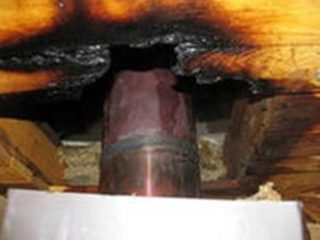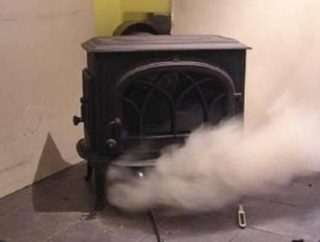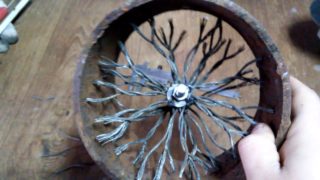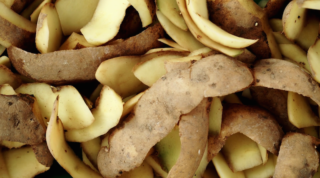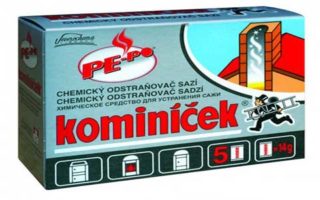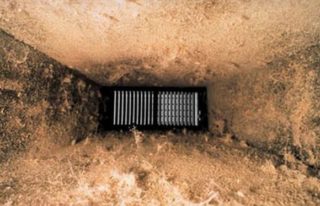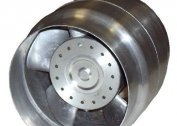Heating of multi-story, private houses and heating of baths is quite often carried out by solid fuel boilers. These devices during operation produce a large amount of gaseous products of combustion, which settle on all surfaces in contact with them. Regular cleaning of the chimney from soot is a must for efficient and safe operation of the stove. For this, you do not need a professional chimney sweep. There are many approaches to this process. Almost everything can be done with your own hands. To achieve a high-quality result with minimal effort and risk to life, you should familiarize yourself with the available methods and means for cleaning the chimney.
What causes chimney clogging
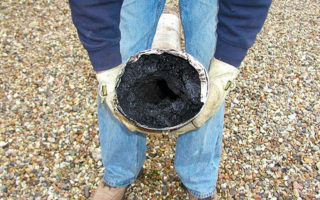
Almost all stokers of boiler houses of multi-storey buildings and owners of their own mansions have to deal with a decrease in the cross-section of the pipe due to plaque formed on its inner wall. In this case, an immediate cleaning of the chimney is carried out, since otherwise the combustion of the fuel may cease, and carbon monoxide will begin to flow into the room.
Chimney clogging can occur for the following reasons:
- Use of raw firewood. After contact with the coals, they do not ignite immediately, but only after drying. During this period, the temperature in the furnace decreases, and the tar evaporates from the logs. This substance does not burn, rising up cools down, settling on the walls of the channel. Subsequently, solid smoke particles adhere to the sticky resin, forming a dense substance.
- Bad traction. Often this phenomenon is the result of design errors - a short, excessively narrow or wide pipe, a narrowing of the channel in the form of a bottle, the presence of a large number of elbows. Sometimes thrust is absent when there is calm, cloudy weather, accompanied by increased atmospheric pressure. In such situations, combustion passes into decay with the formation of thick smoke deposited on the pipe.
- Burning home clothes, waste plastic panels, particleboard and plywood. These materials emit a lot of soot, which is why you need to clean the chimney immediately after disposal.
- Type of fuel. Least soot emit firewood from deciduous trees, but their cost is quite high, which does not justify the cost of the purchase. Coal, spruce and pine are cheaper, but they contain resins, which when heated turn into creosote, which is difficult to remove. To clean the chimney in the bath, you have to spend a lot of time and effort.
- The material of which the chimney is made. Most soot deposits in the brick channels due to their rough surface. Ferrous iron quickly rusts from acid, which is formed upon contact of condensate and soot. The best options are ceramics, glass and stainless steel.
Compliance with all recommendations on the operation of the boiler does not guarantee that the chimney will always be clean. Sooner or later, you will have to get rid of soot.
Danger of clogging and cleaning
The risk of chimney clogging should not be underestimated. This situation can cause tragic events.
The consequences of operating the furnace with a soot clogged pipe:
- Ignition Creosote accumulating in the channel is combustible and forms a flame of high temperature. This is fraught with a fire, first on the roof, and then throughout the house.Sparks can get into neighboring buildings and flammable objects on the street. The scale of destruction can be disastrous.
- Explosion. With strong heating, the soot explodes. At the same time, there is a big risk that the pipe will shatter into fragments that will injure people, animals, damage the roof and courtyard objects.
- Decrease in fuel combustion rate. The result is a low water temperature in the heating system. This is not only discomfort, but also the formation of dampness, mold, the development of a number of diseases among residents.
- Allergic reactions in humans and pets. Small particles of soot and dust fall into the furnace, and from there into the apartment, delivering a lot of troubles to its inhabitants, including the formation of dirt on all things.
- The risk of carbon monoxide poisoning. With a large amount of fuel, the gas mixture does not have time to pass through a narrow passage, part of it comes out.
- Equipment breakdown. If the heat generated during fuel combustion will not be removed from the furnace, the boiler will overheat and fail. In winter, this is very undesirable.
To clean the chimney pipe in a private house, there is no need to wait for the deadlines set or recommended by the manufacturers. It is better to do this more often, without bringing the situation to a critical state.
Frequency of events
It is recommended to carry out cleaning once a year in the spring after the end of the boiler operation, if it is heated in accordance with the instructions.
The following factors affect the timing of cleaning the chimney:
- The date of the last procedure, how it was carried out and what was the degree of contamination.
- Channel Configuration The number of knees and contours.
- Pipe material. The smoothness of the interior walls.
- The fuel used is coal and raw firewood.
- Was the oven used to recycle paper, plastic and synthetic fabrics.
The following signs indicate the need to clean the chimney:
- Traction reduction. Leakage of smoke into the room.
- The color of the flame in the firebox changes from bright orange to red.
- Emission of thick black smoke.
- The appearance of a large amount of dust on the floor, things, interior items.
- The characteristic smell of creosote.
You can visually check the condition of the pipe using a flashlight. To do this, you have to climb onto the roof. If the chimney has bends, a load is lowered inside. By how freely it moves, the level of pollution is calculated.
In bath stoves, pipes need to be cleaned once a year. In continuous burning boilers, the process must be carried out every 2-3 months.
Existing chimney cleaning methods and process descriptions
The tool for cleaning chimneys from soot is selected based on an assessment of the thickness and density of the soot layer, the height and shape of the pipe, the availability of improvised and professional tools, and their own physical capabilities. You should choose a method that, with minimal risk, will bring the most high-quality result. It should be remembered that carelessness is fraught with damage to the heating system and injuries.
Mechanical way
The most effective is the removal of soot by the application of physical effort. This is done with the help of a ruff with a hard pile. If the channel is heavily clogged, it is necessary to have several brushes for its phased expansion. The method of work is simple - the brush moves down and up, the pile cleans the soot, which is poured down. Soot removal can be performed both above and below, if the design of the chimney allows.
There are such varieties of ruffs:
- On a rope with a heavy load under the tool. Here part of the work is done by gravity. After the next ascent, the device is released and flies through the pipe, capturing the soot.
- On the team bar. The device is suitable to remove deposits from direct channels.Sections are wound as they deepen, similar to a drilling rig.
- On a flexible shaft. This is the most versatile device that can clean chimneys of any configuration. The cable is flexible enough to pass knees and contours, and rigid so as not to crumple under load. Thanks to these properties, there is no need to disassemble pipelines of complex shape.
A prerequisite for work is the observance of the following safety measures:
- the presence of a safety belt;
- non-slip shoes with treads;
- safety glasses and gloves;
- gauze bandage;
- dry, calm weather;
- adequate physiological condition.
Before cleaning, close all inspection hatches, cover the fireplace with a wet rag.
Folk ways
There are many effective ways with which you can clean the chimneys in the stove with folk remedies. The techniques have been tested for centuries and work perfectly in modern conditions.
Options for cleaning chimneys folk remedies:
- Boiling water. Soot has a porous structure and absorbs moisture well. Hot liquid is slowly poured into the pipe just before kindling. With further heating, the absorbed water boils, which leads to the destruction and delamination of the plaque.
- Rock salt. When saturated with sodium chloride vapor, the resin hardens, cracks and falls off the channel walls. Salt needs to be poured on firewood or smoldering coals. To achieve the desired result, the procedure is recommended to be performed weekly.
- A mixture of nitrate and sulphate. The components are mixed in equal volumes with powdered charcoal. The tool is added to the working firebox. After exposure to vapors, deposits become brittle and fall down under their own weight.
- Potatoes. Sliced tubers and peeling are involved. They are loaded on top of burning fuel, and the evolving starch fumes soften hard growths. Subsequently, they are easy to remove with a ruff.
- Naphthalene. This is an excellent tool, under the influence of which the soot is stratified and carried out by ascending streams. Minus - persistent pungent odor that remains in the furnace.
- Aspen firewood. This type of wood produces a lot of heat when burned. Use aspen to burn out deposits up to 4 mm thick. If there is more soot, it can explode from strong heat.
If folk methods do not work, you should go to the means of industrial production, developed for such cases.
Chemicals
Household chemicals for cleaning chimneys are efficient, safe and easy to use. Some preparations have catalytic properties that cause a change in the composition of soot and its complete combustion. Other agents act on resins, turning them into a hard and brittle substance. Products can be purchased at specialized retail outlets and online stores.
Manufacturers offer consumers the following products:
- Granules. The most popular is the Kominicek cleaner produced in the Czech Republic. Pellets directly in the package are placed on burning fuel. Under the influence of released substances, a catalytic reaction occurs in soot and it completely burns out.
- Polena "Chimney sweep". They include components that soften hard deposits. With further heating, they evaporate and evaporate with smoke. It remains only to drain the condensate from the sump.
- Powders. Stacked directly in the furnace for firewood or coals. In the process of burning fuel, smoke is emitted, which changes the chemical composition of deposits. After that, they either burn at low temperature or become brittle.
After applying the chemicals, a couple of aspen firewood should be burned in the furnace and the room should be well ventilated. This will get rid of fumes, odors and soot residues.
Cleaning Quality Control
At the end of pipe cleaning, it is necessary to verify the quality of the result achieved. Otherwise, undesirable phenomena and repeated operation after cooling of the heating system are possible.
You can check the condition of the chimney in the following ways:
- Visually. The method is suitable only for straight channels without bends and turns. It will require a powerful flashlight to create a bright beam.
- A round and heavy object, 2-3 cm smaller in diameter than a pipe. This can be a kettlebell, medical ball, a ball filled with water and other objects. From how freely the object slides through the channel, the quality of cleaning is determined.
- Test firebox. Enough of the old newspaper to determine traction. If the thing burned burns quickly and the process is accompanied by a characteristic roar, the goal of cleaning is achieved.
You can attach a sheet of paper to the firebox opening. If he snuggles firmly against him and then gets pulled in, the work is done perfectly.
Useful Tips
Even sandwich pipes are not immune from the formation of soot deposits. The clogging situation is much easier to prevent than to eliminate.
You need to follow these recommendations:
- do not use gasoline to remove soot - it can cause an explosion and fire;
- use aspen firewood only in small quantities - their heat can burn steel;
- periodically carry out preventive measures using mechanical, chemical and folk remedies;
- check the condition of the chimneys every 3 months.
The implementation of these simple rules will save property owners from the difficulties associated with cleaning chimneys.
